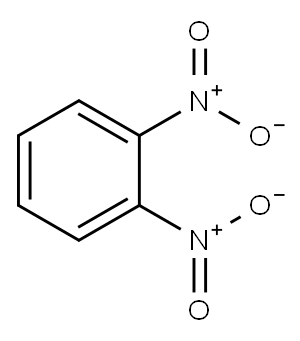1,2-Dinitrobenzene

- CAS No.
- 528-29-0
- Chemical Name:
- 1,2-Dinitrobenzene
- Synonyms
- 1,2-DNB;nsc60682;1.2-Dinitr;o-dinitro-benzen;O-DINITROBENZENE;1,2-Dinitrobenzol;1,2-dinitro-benzen;Benzene,o-dinitro-;1,2-DINITROBENZENE;Benzene, o-dinitro-
- CBNumber:
- CB8853736
- Molecular Formula:
- C6H4N2O4
- Molecular Weight:
- 168.11
- MOL File:
- 528-29-0.mol
- Modify Date:
- 2025/1/27 9:38:02
| Melting point | 116 °C |
|---|---|
| Boiling point | 319 °C773 mm Hg(lit.) |
| Density | 1.57 |
| refractive index | 1.5650 |
| Flash point | 150 °C |
| solubility | chloroform: soluble5%, clear, yellow-green |
| form | solid |
| color | Colorless to yellow needles |
| Water Solubility | 150 mg/L (20 ºC) |
| Merck | 14,3273 |
| BRN | 642224 |
| Exposure limits | NIOSH REL: TWA 1, IDLH 50; OSHA PEL: TWA 1; ACGIH TLV: TWA 0.15 ppm for all isomers (adopted). |
| CAS DataBase Reference | 528-29-0(CAS DataBase Reference) |
| NIST Chemistry Reference | Benzene, 1,2-dinitro-(528-29-0) |
| EPA Substance Registry System | o-Dinitrobenzene (528-29-0) |
SAFETY
Risk and Safety Statements
| Symbol(GHS) |    GHS06,GHS08,GHS09 |
|||||||||
|---|---|---|---|---|---|---|---|---|---|---|
| Signal word | Danger | |||||||||
| Hazard statements | H300+H310+H330-H373-H410 | |||||||||
| Precautionary statements | P262-P264-P273-P280-P302+P352+P310-P304+P340+P310 | |||||||||
| Hazard Codes | T+,N | |||||||||
| Risk Statements | 26/27/28-33-50/53 | |||||||||
| Safety Statements | 28-36/37-45-60-61-28A | |||||||||
| RIDADR | UN 3443 6.1/PG 2 | |||||||||
| OEB | C | |||||||||
| OEL | TWA: 1 mg/m3 [skin] | |||||||||
| WGK Germany | 3 | |||||||||
| RTECS | CZ7450000 | |||||||||
| HazardClass | 6.1(a) | |||||||||
| PackingGroup | II | |||||||||
| HS Code | 29042000 | |||||||||
| Hazardous Substances Data | 528-29-0(Hazardous Substances Data) | |||||||||
| Toxicity | IC50 (24-h) for river bacteria 1.80 mg/L (Yuan and Lang, 1997). | |||||||||
| IDLA | 50 mg/m3 | |||||||||
| NFPA 704 |
|
1,2-Dinitrobenzene price More Price(11)
| Manufacturer | Product number | Product description | CAS number | Packaging | Price | Updated | Buy |
|---|---|---|---|---|---|---|---|
| Sigma-Aldrich | 302066 | 1,2-Dinitrobenzene ≥99% | 528-29-0 | 1G | ₹3671.4 | 2022-06-14 | Buy |
| Sigma-Aldrich(India) | 302066 | 1,2-Dinitrobenzene ≥99% | 528-29-0 | 1G | ₹3671.4 | 2022-06-14 | Buy |
| Sigma-Aldrich | 302066 | 1,2-Dinitrobenzene ≥99% | 528-29-0 | 5G | ₹9484.45 | 2022-06-14 | Buy |
| Sigma-Aldrich(India) | 302066 | 1,2-Dinitrobenzene ≥99% | 528-29-0 | 5G | ₹9484.45 | 2022-06-14 | Buy |
| Sigma-Aldrich | 126632 | 1,2-Dinitrobenzene 97% | 528-29-0 | 5G | ₹8862 | 2022-06-14 | Buy |
1,2-Dinitrobenzene Chemical Properties,Uses,Production
Chemical Properties
light yellow-brown powder
Uses
1,2-Dinitrobenzene was used as internal standard for analysis of the explosives, TNT, RDX, and tetryl in sea water by vapor phase chromatography with the nickel-63 electron capture detector.
General Description
Colorless to yellow solid. Sinks and slowly mixes with water.
Air & Water Reactions
Slowly mixes with water.
Reactivity Profile
All three isomers have similar properties and may react vigorously with oxidizing materials. Their reaction with nitric acid (nitration) will lead to a mixture of trinitrobenzenes possessing high-explosive properties [Urbanski, 1967, vol. 3, p. 290]. If heat and reaction conditions of the nitration are not controlled, detonation comparable to TNT may occur [Anon., J. R. Inst. Chem., 1960, 84, p. 451]. Mixture of 1,3-dinitrobenzene with tetranitromethane was found highly explosive [Urbanski, 1964, vol. 1, 592]. 1,2-dinitrobenzene is a severe explosion hazard when shocked or exposed to heat or flame. When heated to decomposition all dinitrobenzens emit toxic fumes of nitrogen oxides [Sax, 9th ed., 1996, p. 1374].
Health Hazard
INHALATION, INGESTION, OR SKIN ABSORPTION: Headache, vertigo and vomiting followed by exhaustion, numbness of the legs, staggering and collapse. Intense methemoglobinenia may lead to asphyxia severe enough to injure the CNS. EYES: Irritation. SKIN: Stains skin yellow.
Safety Profile
Suspected carcinogen. Poison by inhalation and ingestion. Moderately toxic by sktn contact. Can cause liver, kidney, and central nervous system injury. Combustible when exposed to heat or flame; can react vigorously with oxidzing materials. A severe explosion hazard when shocked or exposed to heat or flame. It is used in bursting charges and to fiu artillery shells. Mixtures with nitric acid are highly explosive. To fight fire, use water, Co2, dry chemical. Dangerous; when heated to decomposition it emits highly toxic fumes of NO, and explodes. See also mand pDINITROBENZENE and NITRO COMPOUNDS of AROMATIC HYDROCARBONS.
Environmental Fate
Biological. Under anaerobic and aerobic conditions using a sewage inoculum, 1,2-dinitrobenzene degraded to nitroaniline (Hallas and Alexander, 1983).
Photolytic. Low et al. (1991) reported that the nitro-containing compounds (e.g., 2,4-
dinitrophenol) undergo degradation by UV light in the presence of titanium dioxide yielding
ammonium, carbonate, and nitrate ions. By analogy, 1,2-dinitrobenzene should degrade forming
identical ions.
Chemical/Physical. Releases toxic nitrogen oxides when heated to decomposition (Sax and
Lewis, 1987). 1,2-Dinitrobenzene will not hydrolyze in water (Kollig, 1993).
Purification Methods
Crystallise it from EtOH. [Beilstein 5 IV 738.]
1,2-Dinitrobenzene Preparation Products And Raw materials
Raw materials
Preparation Products
1of3
chevron_right528-29-0(1,2-Dinitrobenzene)Related Search:
1of4
chevron_right




